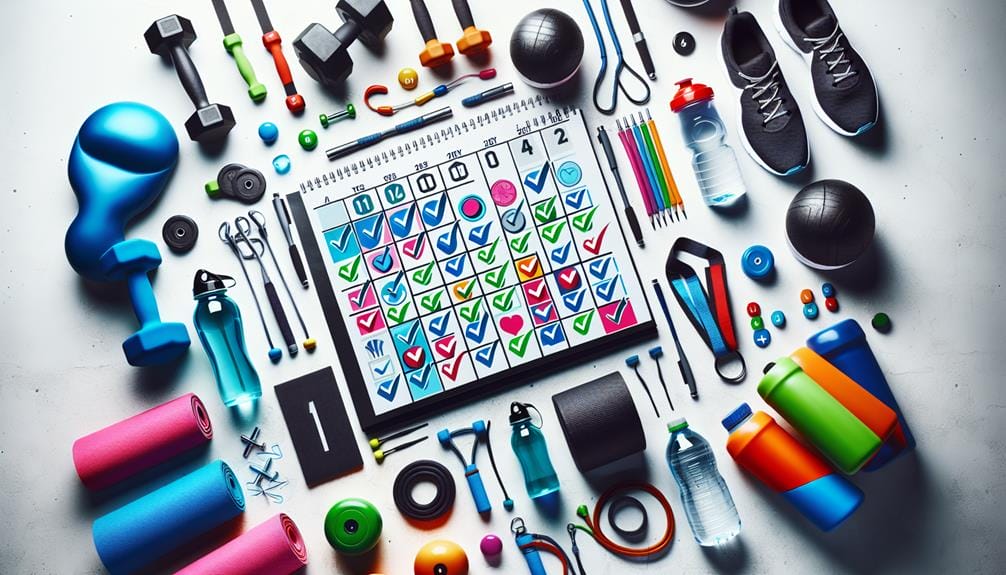First, set clear fitness goals using the SMART method to keep them specific and measurable. Assess your current fitness level, considering strength, flexibility, and endurance. Choose exercises that target various muscle groups, including strength training, cardio, and flexibility exercises. Plan to work out 3-5 times a week, balancing with rest days for recovery. Include active recovery activities like walking or yoga to prevent overtraining. Track your progress regularly and make adjustments as needed. Celebrate small achievements to stay motivated and reinforce your success. By following these steps, you'll build an effective and sustainable fitness plan.
Key Takeaways
- Set clear, SMART goals to define and measure your fitness objectives.
- Assess your current fitness level by evaluating strength, flexibility, and cardiovascular endurance.
- Choose a variety of exercises, including strength training, cardio, and flexibility workouts.
- Schedule 3-5 workout sessions per week, balancing with rest days for recovery.
- Incorporate active recovery like walking or yoga to prevent overtraining and enhance performance.
Set Clear Fitness Goals
To create an effective fitness plan, start by setting clear and specific fitness goals. You can't just say, 'I want to be fit,' and expect magic to happen. Instead, use SMART goals—specific, measurable, actionable, realistic, and timely.
For example, turn 'I want to get in shape' into 'I will run a 5k in 3 months.' When your goals align with your desires and motivations, you're more likely to succeed. Think about what drives you. Do you want to impress your future self or just fit into those jeans from five years ago? Whatever your motivations, make sure they guide your fitness plan effectively.
Setting clear goals will keep you focused, motivated, and on track.
Assess Your Current Fitness

To start your fitness plan, assess your current fitness by evaluating your physical strength and measuring your endurance levels. This gives you a clear picture of where you stand and what areas need improvement.
Use tools like fitness apps or consult with a professional to get accurate readings.
Evaluate Physical Strength
Start by measuring your fitness level through pulse rate, endurance, strength, flexibility, and BMI assessments. Knowing your current fitness level helps you tailor your fitness plan and evaluate physical strength. You'll need to assess muscular fitness to see where you stand. Don't worry; you won't need a PhD for this. A strength training workout will help gauge your baseline. Once you know your strengths (and, ahem, weaknesses), you can measure your progress and tweak your routine.
Here's a quick table to help visualize some assessments:
| Assessment | What to Measure | How to Measure |
|---|---|---|
| Strength | Push-ups, Sit-ups | Count reps in 1 minute |
| Flexibility | Sit and Reach Test | Measure distance reached |
| BMI | Height and Weight | Calculate using BMI formula |
You've got this!
Measure Endurance Levels
Evaluating your endurance levels gives you a clear picture of how well your body sustains prolonged physical activity. Grab your sneakers and channel your inner marathoner by using the Cooper Test or a timed run/walk. These tests measure how long you can keep up the sweat fest, revealing your cardiovascular endurance.
Record the distance covered or time taken to establish a baseline. This data helps you set realistic fitness goals and tailor your exercise, training, and workout plans to match the Activity Guidelines for Americans.
Regularly testing your endurance can track progress and keep you motivated. Remember, the journey to improved fitness is a marathon, not a sprint – so get moving and keep going!
Choose Your Exercises
Selecting the right exercises is essential for achieving your specific fitness goals. You might think one exercise is enough, but to keep things fun and effective, choose activities targeting various muscle groups. This way, your workout plan stays dynamic, and you avoid getting bored quicker than a hamster on a wheel.
Mix in some strength training, cardio, and flexibility exercises to cover all bases. These health tips will help you stay committed and see progress. Enjoyment is key, so pick exercises you actually like. Don't forget to consult a fitness professional for proper form and technique.
Customize your plan based on your fitness level, preferences, and any physical limitations. Happy sweating!
Plan Workout Frequency

To guarantee your fitness plan is effective, aim for 3-5 workout sessions per week to maintain consistency and see progress.
Balance these sessions with rest days to allow muscle recovery and prevent overtraining.
Incorporate a mix of activities like weight training, HIIT, and running to keep your routine varied and engaging.
Determine Weekly Sessions
When planning your workout frequency, aim for 3-5 sessions per week to achieve peak fitness results. Think of it as Goldilocks and the Three Bears: not too few, not too many, just right.
The Physical Activity Guidelines recommend at least 150 minutes of moderate exercise weekly. So, break that down into manageable bites. You could do 30-minute sessions five days per week or 50 minutes three times a week.
Don't forget your rest days! They're as essential as your workout days to prevent burnout and aid muscle recovery.
In your weekly plan, mix in some cardio, strength training, and flexibility exercises to keep things spicy and effective.
Now, get moving – but not too fast!
Balance Rest and Activity
Balancing rest and activity is crucial for a sustainable and effective fitness plan. Don't skip rest days; they're not just for binge-watching shows. Aim for a balanced workout frequency of 3-5 days per week. This gives your muscles time to recover and prevents muscle fatigue.
Alternate between workout days and rest days to keep things consistent. Sprinkle in some active recovery like walking, yoga, or swimming on those rest days to keep everything limber. Planning a weekly schedule with dedicated rest days guarantees you're not overdoing it and supports long-term progress.
Schedule Active Recovery

Incorporating active recovery days into your fitness plan is essential for muscle repair and overall performance. Think of it as your body's version of Netflix and chill—only with low-intensity activities like walking, yoga, or foam rolling. These activities aid in muscle repair and flexibility without making you feel like a worn-out sock.
By scheduling two active recovery days per week, you can prevent overtraining and avoid turning into a fitness zombie. Alternating between high-intensity workouts and active recovery will boost your fitness levels and keep you consistent without the dreaded burnout.
Plus, mixing in different activities during active recovery days will improve your mobility, reduce soreness, and make you feel like a well-oiled machine.
Track Your Progress

After ensuring your body gets the recovery it needs, it's time to focus on tracking your progress to stay on top of your fitness journey. Use a workout journal or app to record metrics like weight lifted, repetitions, and workout duration. Wearable technology, like fitness trackers, can give you real-time insights. Celebrate small successes to keep motivation high. Here's a quick guide:
| Metric | How to Track | Why It Matters |
|---|---|---|
| Weight Lifted | Workout Journal | Measures strength gains |
| Repetitions | App | Tracks endurance improvements |
| Workout Duration | Fitness Tracker | Monitors cardiovascular health |
| Steps Taken | Wearable Technology | Encourages daily activity |
| Calories Burned | Fitness Tracker | Helps manage weight goals |
Keep track of these metrics for effective progress tracking.
Adjust Your Plan

How do you know when it's time to adjust your fitness plan?
If your routine feels like a chore or life throws you a curveball, it's time to be flexible. Trust your instincts and give yourself permission to accommodate changes in your schedule or preferences.
Consistency is key, so modify your plan to make sure you keep showing up. Don't be a robot; life's unpredictable! Embrace the process, knowing it's part of the journey to better well-being.
Maybe you've hit a plateau, or your goals have shifted—whatever the reason, making changes is all about staying on track. Remember, your fitness plan should work for you, not the other way around.
Celebrate Milestones

Once you've adjusted your plan, it's important to celebrate milestones to stay motivated and acknowledge your progress. Don't underestimate the power of small wins in your fitness journey. Whether you finally conquered that five-minute plank or managed to resist the siren call of junk food, these achievements deserve a mini party.
Celebrating milestones boosts your motivation and reinforces your progress, creating a positive feedback loop. Treat yourself to a healthy reward, like a new pair of workout socks or a smoothie, and share your success with friends.
Regularly recognizing your achievements keeps the momentum going and gives you a sense of accomplishment. So, go ahead, do a victory dance—your fitness journey deserves it!
Conclusion
You've got all the tools to craft a fitness plan that works for you. Remember, setting clear goals and evaluating your fitness are your foundation. Choose exercises that excite you, plan your workout frequency, and don't forget active recovery. Track your progress and adjust as needed.
Celebrate each milestone, no matter how small. Consistency is your best friend, and with dedication, you'll see results. Your journey to fitness starts now—take that first step.









Leave a Comment